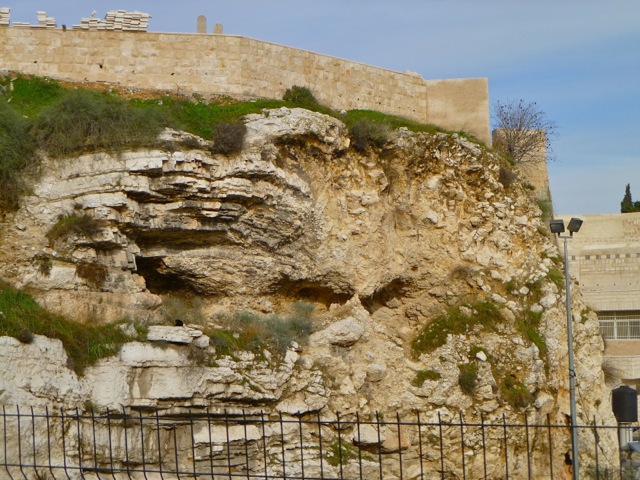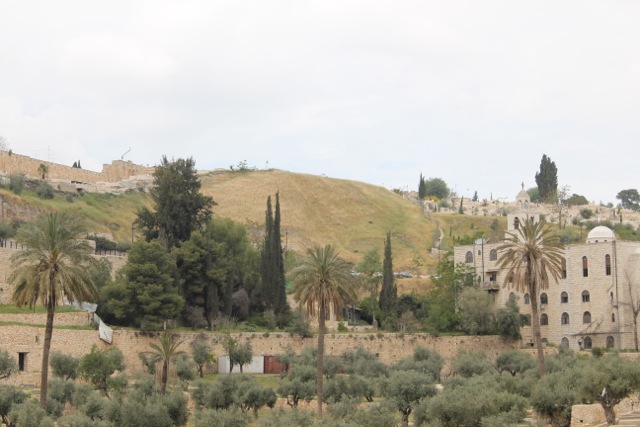Where was Jesus Crucified and Buried?
One of the most treasured places to Christians is the Garden Tomb north of the Damascus Gate in Jerusalem. This site is held by most Christians to be the site where Jesus was crucified and buried. The tomb there was sealed with a large stone that was rolled in front of the door. This tomb is believed to be where Jesus was buried. An ancient wine press was found nearby indicating that there was a garden there also. Just east of the tomb is a hill that has natural features which resemble a skull.
Christians travel from all over the world to visit the Garden tomb. Many visitors say that it is peaceful and they feel very close to God there. But is this the actual place where Jesus was crucified, buried, and rose from the dead? Many will argue, “What does it matter as long as I feel close to God there?” We might be missing some significant details that should be important to us as believers. Remember, I said in my last article that the details of the archaeology glorify God.
Let’s first take a quick look at how this site became traditionally known as the site of Christ’s crucifixion, burial, and resurrection. The Garden Tomb is also known as Gordon’s Calvary. General Charles Gordon of the British army strongly believed that this site was the authentic location of Christ’s tomb. He visited the site in 1883. Many tour guides and writers wrongly credit General Gordon with the discovery of the tomb. Other men before Gordon held that this was the correct place. Gordon’s conversations with Claude Conder and Conrad Schick gave him the compelling reasons to hold this as the authentic site.
I am not going to write a lengthy thesis on the archaeological and historical fallacies of the site. Let’s just look at the Bible to locate the correct site of Christ’s death, burial, and resurrection.
One of the most important Theological statements in the Bible is commonly overlooked. When Christ died on the cross, the veil in the Temple was torn in two from top to bottom. Matthew, Mark, and Luke all record this event. Mark is very clear about some geographical details in his account that easily identify the site we are looking for.
In Mark 15:38 it is recorded that the veil in the Temple was torn in two from top to bottom. Then in the next verse it says that the centurion saw it happen. The original Greek text is very clear about what took place that day. It says, “And because the centurion who stood in front of Him (Jesus) beholding (the veil torn in two) that when His spirit left Him (Jesus) he said, ‘Truly this was the Son of God.” The Roman centurion was appointed by the Roman government to make sure Jesus died because He was considered a threat to the Roman government and a traitor to the Jewish establishment. For the centurion to make such a bold statement, he put his life in jeopardy of the same fate. What did he see that caused him to make such a bold statement? It was not Jesus taking His last breath or dying. It was the veil of the Temple being torn in two from top to bottom.
The fact that the centurion saw the veil torn in two tells us much about Christ’s death. Christ was crucified outside of the walls of Jerusalem. In order for the centurion to see the veil in the Temple he had to be outside the Eastern Gate. The doors to the Temple had to be open and the Eastern Gate had to be open. The doors to the Temple were open because it was Passover and the High Priest was offering the Passover sacrifice.
The Eastern gate was used for one specific purpose: the sacrifice of the red heifer. The law of the red heifer is written in Numbers 19. Whenever the Temple needed to be sanctified the High Priest would sacrifice a red heifer on the Mount of Olives. He would burn it with cedar, hyssop, and scarlet. He would mix the ashes with water from the Gihon Spring to anoint himself, his clothing, and utensils. He would cross the Kidron Valley on a bridge made specifically for the priest to enter through the Eastern Gate and into the Temple with the blood and ashes of the red heifer. Whenever the Eastern Gate was not in use it was blocked up. The blocks would be removed only in the year of the sacrifice of the red heifer.
If the centurion could see the veil torn as Mark records then it had to be during Passover and during the time of the sacrifice of the red heifer. This is very important to our theology! Jesus was our Passover sacrifice and our red heifer sacrifice. Jesus was all of our sacrifices in one. People become aware of these important details when they examine specifics of the texts concerning Christ’s death.
Christians travel from all over the world to visit the Garden tomb. Many visitors say that it is peaceful and they feel very close to God there. But is this the actual place where Jesus was crucified, buried, and rose from the dead? Many will argue, “What does it matter as long as I feel close to God there?” We might be missing some significant details that should be important to us as believers. Remember, I said in my last article that the details of the archaeology glorify God.
Let’s first take a quick look at how this site became traditionally known as the site of Christ’s crucifixion, burial, and resurrection. The Garden Tomb is also known as Gordon’s Calvary. General Charles Gordon of the British army strongly believed that this site was the authentic location of Christ’s tomb. He visited the site in 1883. Many tour guides and writers wrongly credit General Gordon with the discovery of the tomb. Other men before Gordon held that this was the correct place. Gordon’s conversations with Claude Conder and Conrad Schick gave him the compelling reasons to hold this as the authentic site.
I am not going to write a lengthy thesis on the archaeological and historical fallacies of the site. Let’s just look at the Bible to locate the correct site of Christ’s death, burial, and resurrection.
One of the most important Theological statements in the Bible is commonly overlooked. When Christ died on the cross, the veil in the Temple was torn in two from top to bottom. Matthew, Mark, and Luke all record this event. Mark is very clear about some geographical details in his account that easily identify the site we are looking for.
In Mark 15:38 it is recorded that the veil in the Temple was torn in two from top to bottom. Then in the next verse it says that the centurion saw it happen. The original Greek text is very clear about what took place that day. It says, “And because the centurion who stood in front of Him (Jesus) beholding (the veil torn in two) that when His spirit left Him (Jesus) he said, ‘Truly this was the Son of God.” The Roman centurion was appointed by the Roman government to make sure Jesus died because He was considered a threat to the Roman government and a traitor to the Jewish establishment. For the centurion to make such a bold statement, he put his life in jeopardy of the same fate. What did he see that caused him to make such a bold statement? It was not Jesus taking His last breath or dying. It was the veil of the Temple being torn in two from top to bottom.
The fact that the centurion saw the veil torn in two tells us much about Christ’s death. Christ was crucified outside of the walls of Jerusalem. In order for the centurion to see the veil in the Temple he had to be outside the Eastern Gate. The doors to the Temple had to be open and the Eastern Gate had to be open. The doors to the Temple were open because it was Passover and the High Priest was offering the Passover sacrifice.
The Eastern gate was used for one specific purpose: the sacrifice of the red heifer. The law of the red heifer is written in Numbers 19. Whenever the Temple needed to be sanctified the High Priest would sacrifice a red heifer on the Mount of Olives. He would burn it with cedar, hyssop, and scarlet. He would mix the ashes with water from the Gihon Spring to anoint himself, his clothing, and utensils. He would cross the Kidron Valley on a bridge made specifically for the priest to enter through the Eastern Gate and into the Temple with the blood and ashes of the red heifer. Whenever the Eastern Gate was not in use it was blocked up. The blocks would be removed only in the year of the sacrifice of the red heifer.
If the centurion could see the veil torn as Mark records then it had to be during Passover and during the time of the sacrifice of the red heifer. This is very important to our theology! Jesus was our Passover sacrifice and our red heifer sacrifice. Jesus was all of our sacrifices in one. People become aware of these important details when they examine specifics of the texts concerning Christ’s death.
In light of the details above, where was Golgotha (the place Jesus was crucified)? Golgotha in the Greek means the place of the skull. One of the main arguments for Gordon’s Calvary being the correct location is the hill there resembles a skull. The Greek name Golgotha comes from an Aramaic word which means skull. Specifically this is a broken skull or decapitated skull. The “place of the skull” does not mean a place that looks like a skull. It refers to the place where skulls are made or people are killed.
The hill where Jesus was crucified had to be outside the Eastern Gate of Jerusalem on the hill just north of the red heifer bridge. This is the only place where the centurion would have been able to see the veil of the Temple torn. Today this place is just outside Saint Stephen’s Gate. Jesus was buried in a garden near by. Very close to the hill by Saint Stephen’s Gate is the Garden of Gethsemane where Jesus often spent time with His disciples and in prayer. Mary’s uncle, Joseph of Arimathea, owned a plot in this prestigious piece of real estate. In this plot he had a tomb made for himself, which he gave for Jesus’ burial. It was here that Mary Magdalene and Mary the sister of Lazarus came on the first day of the week to find the tomb empty because Jesus had risen.
© Dr. Steven L Smith 2016
The hill where Jesus was crucified had to be outside the Eastern Gate of Jerusalem on the hill just north of the red heifer bridge. This is the only place where the centurion would have been able to see the veil of the Temple torn. Today this place is just outside Saint Stephen’s Gate. Jesus was buried in a garden near by. Very close to the hill by Saint Stephen’s Gate is the Garden of Gethsemane where Jesus often spent time with His disciples and in prayer. Mary’s uncle, Joseph of Arimathea, owned a plot in this prestigious piece of real estate. In this plot he had a tomb made for himself, which he gave for Jesus’ burial. It was here that Mary Magdalene and Mary the sister of Lazarus came on the first day of the week to find the tomb empty because Jesus had risen.
© Dr. Steven L Smith 2016

